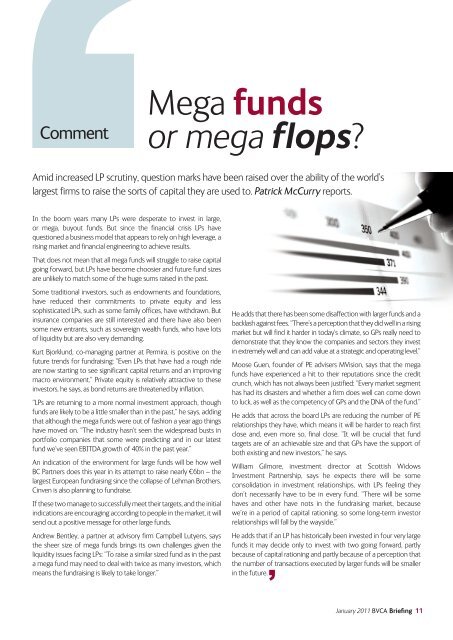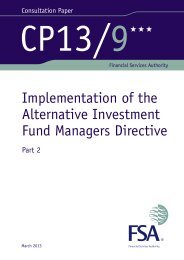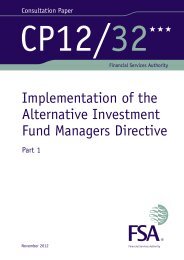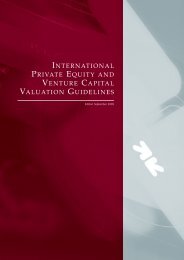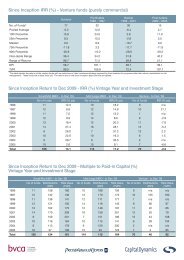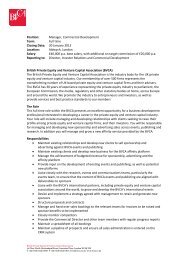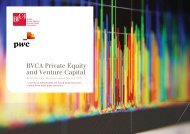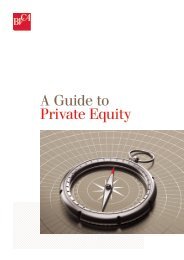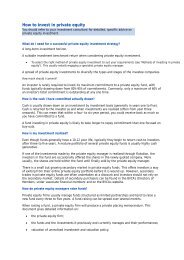fundraising special - BVCA admin
fundraising special - BVCA admin
fundraising special - BVCA admin
You also want an ePaper? Increase the reach of your titles
YUMPU automatically turns print PDFs into web optimized ePapers that Google loves.
Comment<br />
Mega funds<br />
or mega flops?<br />
Amid increased LP scrutiny, question marks have been raised over the ability of the world’s<br />
largest firms to raise the sorts of capital they are used to. Patrick McCurry reports.<br />
In the boom years many LPs were desperate to invest in large,<br />
or mega, buyout funds. But since the financial crisis LPs have<br />
questioned a business model that appears to rely on high leverage, a<br />
rising market and financial engineering to achieve results.<br />
That does not mean that all mega funds will struggle to raise capital<br />
going forward, but LPs have become choosier and future fund sizes<br />
are unlikely to match some of the huge sums raised in the past.<br />
Some traditional investors, such as endowments and foundations,<br />
have reduced their commitments to private equity and less<br />
sophisticated LPs, such as some family offices, have withdrawn. But<br />
insurance companies are still interested and there have also been<br />
some new entrants, such as sovereign wealth funds, who have lots<br />
of liquidity but are also very demanding.<br />
Kurt Bjorklund, co-managing partner at Permira, is positive on the<br />
future trends for <strong>fundraising</strong>: “Even LPs that have had a rough ride<br />
are now starting to see significant capital returns and an improving<br />
macro environment.” Private equity is relatively attractive to these<br />
investors, he says, as bond returns are threatened by inflation.<br />
“LPs are returning to a more normal investment approach, though<br />
funds are likely to be a little smaller than in the past,” he says, adding<br />
that although the mega funds were out of fashion a year ago things<br />
have moved on. “The industry hasn’t seen the widespread busts in<br />
portfolio companies that some were predicting and in our latest<br />
fund we’ve seen EBITDA growth of 40% in the past year.”<br />
An indication of the environment for large funds will be how well<br />
BC Partners does this year in its attempt to raise nearly €6bn – the<br />
largest European <strong>fundraising</strong> since the collapse of Lehman Brothers.<br />
Cinven is also planning to fundraise.<br />
If these two manage to successfully meet their targets, and the initial<br />
indications are encouraging according to people in the market, it will<br />
send out a positive message for other large funds.<br />
Andrew Bentley, a partner at advisory firm Campbell Lutyens, says<br />
the sheer size of mega funds brings its own challenges given the<br />
liquidity issues facing LPs: “To raise a similar sized fund as in the past<br />
a mega fund may need to deal with twice as many investors, which<br />
means the <strong>fundraising</strong> is likely to take longer.”<br />
He adds that there has been some disaffection with larger funds and a<br />
backlash against fees. “There’s a perception that they did well in a rising<br />
market but will find it harder in today’s climate, so GPs really need to<br />
demonstrate that they know the companies and sectors they invest<br />
in extremely well and can add value at a strategic and operating level.”<br />
Moose Guen, founder of PE advisers MVision, says that the mega<br />
funds have experienced a hit to their reputations since the credit<br />
crunch, which has not always been justified: “Every market segment<br />
has had its disasters and whether a firm does well can come down<br />
to luck, as well as the competency of GPs and the DNA of the fund.”<br />
He adds that across the board LPs are reducing the number of PE<br />
relationships they have, which means it will be harder to reach first<br />
close and, even more so, final close. “It will be crucial that fund<br />
targets are of an achievable size and that GPs have the support of<br />
both existing and new investors,” he says.<br />
William Gilmore, investment director at Scottish Widows<br />
Investment Partnership, says he expects there will be some<br />
consolidation in investment relationships, with LPs feeling they<br />
don’t necessarily have to be in every fund. “There will be some<br />
haves and other have nots in the <strong>fundraising</strong> market, because<br />
we’re in a period of capital rationing, so some long-term investor<br />
relationships will fall by the wayside.”<br />
He adds that if an LP has historically been invested in four very large<br />
funds it may decide only to invest with two going forward, partly<br />
because of capital rationing and partly because of a perception that<br />
the number of transactions executed by larger funds will be smaller<br />
in the future.<br />
January 2011 <strong>BVCA</strong> Briefing 11


